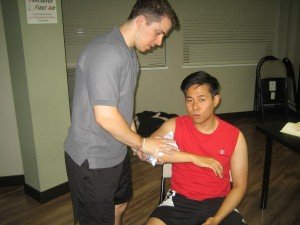Ice hockey is a sport that requires a combination of power, speed and teamwork. Due to this, players face the risk for specific injury patterns. Luckily, most of these hockey injuries can be prevented.
Risk factors for hockey injuries
The risk of ending up with one of the hockey injuries usually depends on various factors including the level of participation, protective equipment used, position of the player, violent behavior and personality susceptibility due to current injuries and manner of play. Always bear in mind that hockey injuries occur frequently in games and increase with each level of participation.
Common hockey injuries
Many athletes who play ice hockey might end up with concussions without losing consciousness. Players, coaches and parents must be well aware of the usual signs and symptoms including headaches and “not feeling right”. Once a player experiences symptoms or displays signs of a concussion, he/she should not return to play and must be properly assessed by a doctor.

Shoulder injuries
The most common hockey injuries involving the shoulder include a broken collarbone and shoulder separation. These injuries typically occur due to direct contact of the shoulder with another player, ice or the boards. The treatment includes the use of a sling, getting enough rest and even surgery in serious cases.
Elbow injuries
The point of the elbow is considered as a frequent area of contact that can result to bursitis. The dense and damaged bursal tissue might be the reason for the persistent inflammation. The ideal preventive measure is to use elbow pads that properly fit and has a hole for the elbow, plastic exterior shell and soft padding.
Wrist injuries
Falls on the outstretched arm or contact with the board that forces the wrist upwards or downwards can lead to a fracture. The player should try bracing against the boards using their forearms instead of the hands.
Back injuries
Hockey injuries involving the low back tend to occur frequently among hockey players. The low back pain and pulled muscle are the common injuries. The best way to avoid these hockey injuries is to stick with a strengthening routine for the back and abdominal muscles.
Knee injuries
The medial collateral ligament (MCL) is highly susceptible to sprains due to the leg position. The disruption of the anterior cruciate ligament (ACL) as well as meniscus tears can also develop but are uncommon in hockey unlike with other sports such as soccer, football and basketball.
Hip injuries
The hip joint and groin muscles are prone to injury due to the mechanics of the skating stride. Some of the most common soft tissue injuries in hockey include groin strain and hip flexor strain.
Strengthening during off-season and stretching before and after practice are vital in order to prevent these injuries. Additionally, sustaining a direct blow strike to the exterior of the hip can lead to hip pointer or even trochanteric bursitis. Using hockey pants that are reinforced with lining over these susceptible areas can provide protection.
